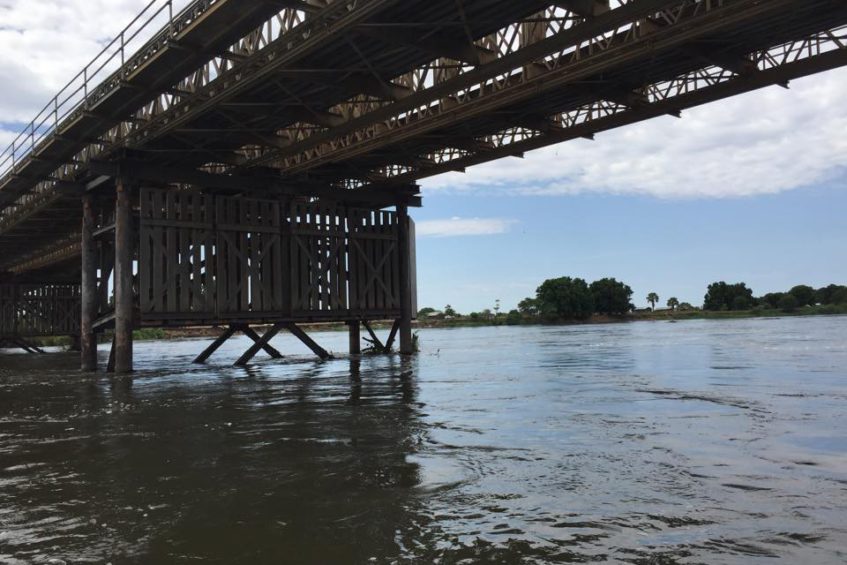You are here: Home | Economy | Featured | National News | News | Finance Ministry withholds $2million for Juba Bridge maintenance

Juba Bridge, South Sudan
The National Roads Authority says it has not received the $2 million it requested this year for the maintenance of the Juba Bridge.
According to the Executive Director, the Ministry of Finance has remained silent on the amount.
Juba Bridge was constructed in 1972 and it underwent some repairs in 2008.
Most of the trucks that enter Juba through Juba Bridge carry fuel and other commodities for the market.
An accident in 2010 left one lane of the bridge unusable for heavy vehicles.
Last week, the Managing Director of Rhino Star Construction Company, which has been handling rehabilitation work on the bridge, urged the government to ban heavy trucks from using the Juba Bridge as it nears collapse.
Peter Atem said the tarmac on the remaining lane is worn out, and the iron bars have been weakened by heavy loads and overuse.
But his warnings have not been heeded to. Trucks are still using the bridge fully loaded with goods. Heavy construction vehicles also cross the bridge unchecked.
“You see a sign right at the entrance of the bridge indicating maximum 45 tons, but who is going to tell whether [the trucks carry] beyond that or below?” asked Engineer Kenyatta Benjamin, Executive Director of Roads Authority.
“Unless you have a weighbridge.”
A weighbridge is usually mounted permanently on a concrete foundation to weigh trucks carrying goods and dimensions. By weighing the vehicle both empty and when loaded, the load carried by the vehicle can be calculated.
Juba Bridge provides the only access over the Nile into much of South Sudan since most goods and foodstuffs imported from Kenya and Uganda passes over the Juba-Nimule Road.
The bridge is composed of two adjacent 252-meter spans and provides the only access over the river Nile to South Sudan.
The Roads Authority says most of the steel used to construct the bridge has to be shipped from overseas.
“The bridge itself is not something that you can buy parts from Konyo-konyo, you have to import it from Britain, the manufacturer of the bridge,” said Eng. Kenyatta.
According to reports, the original Juba Nile Bridge crossing was formed from two WW2-era Bailey Bridges. However, following an earlier collapse of one of the bridges, two replacement Mabey Compact 200 bridges were installed in 2006. It was damaged by a bulldozer in 2010.
Funding for the repair of the Juba Nile Bridge was provided by the United States Agency for International Development (USAID) under the Accelerated Infrastructure Program, a Cooperative Agreement with United Nations Office for Project Services (UNOPS) which strengthened many parts of the country’s infrastructure.
A local contractor won the tender to carry out the repair works. The fully repaired bridge was reopened to full capacity.
But since 2010, no proper maintenance work has been done on the bridge, despite the government allocating huge sums of money towards it every financial year.
In August, the Committee of Transport, Roads and Bridges at the National parliament observed that the Ministry of Finance failed to release the 1.5 billion pounds allocated last year to the Roads Authority.
In this fiscal year 2019/2020 budget, 3 billion pounds has been allocated to the Road Authority for the maintenance of the Juba – Nimule highway, the Juba Nile Bridge and other bridges along the Nimule road.
“On average it is between 5-10 million U.S dollars to install it and maybe $250, 000 a year to maintain it,” Kenyatta revealed.
He urges the Ministry of Finance to immediately release the money allocated for the maintenance of the Juba Bridge.
“We have requested for $2 million to be sent to the supplier so that it ships [materials] to us and then we have local contractors here to start maintaining the bridge.”
“We requested this in May this year [but] up to now we haven’t received any payment,” he added.
In 2012, President Salva Kiir made the repair of the bridges as one of his government’s priorities during the administration’s first 100 days.
“Despite all the other priorities, you can see that the Juba Bridge is really in a critical stage now, and we need to do something about it,” Eng. Kenyatta concluded.
Support Eye Radio, the first independent radio broadcaster of news, information & entertainment in South Sudan.
Make a monthly or a one off contribution.
Copyright 2024. All rights reserved. Eye Radio is a product of Eye Media Limited.